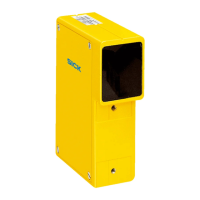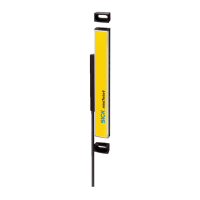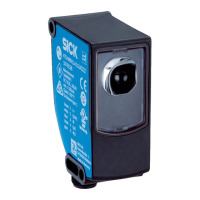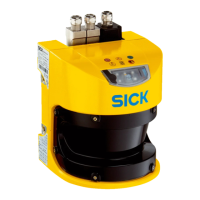4.3.8.2 Calculation example for the minimum distance
Calculation example of the minimum distance S according to ISO 13855
T
he example shows the calculation of the minimum distance for an orthogonal
approach to the protective field. A different calculation may be required depending on
the application and the ambient conditions, e.g. for a protective field parallel to or at
any angle to the direction of approach or an indirect approach.
b
First, calculate S using the following formula:
S = 2,000 mm/s × T +8 ×(d – 14 mm)
where:
°
S = minimum distance in millimeters (mm)
°
T = stopping/run-down time for the entire system in seconds (s)
(Response time of the safety laser scanner + machine’s stopping/run-down
time, incl. response time of the machine’s control system and signal propaga‐
tion time)
°
d = r
esolution of the safety laser scanner in millimeters (mm)
✓
If the result is S ≤ 100 mm, use S = 100 mm.
✓
If the result is 100 mm < S ≤ 500 mm, use the calculated value as the minimum
distance.
b
If the result is S > 500 mm, then recalculate S with the following formula:
S = 1,600 mm/s × T +8 ×(d – 14 mm)
✓
If the new value is S > 500 mm, then use the newly calculated value as the mini‐
mum distance.
✓
If the new value is S ≤ 500 mm, then use S = 500 mm as the minimum distance.
The reach/approach speed is already included in the formula.
4.3.9 Access protection
Overview
T
he safety laser scanner is mounted with a vertical scan plane in a stationary applica‐
tion, for example on a machine, for which access to the hazardous area may be defined
structurally.
For access protection, the safety laser scanner detects an intrusion by a whole body.
The protective field is orthogonal to the direction of approach.
You must monitor a reference contour to protect the safety laser scanner from acciden‐
tal misalignment or manipulation.
4 P
ROJECT PLANNING
30
O P E R A T I N G I N S T R U C T I O N S | nanoScan3 I/O 8024596/15VP/2019-11-15 | SICK
Subject to change without notice

